Physical
Science: Gravitational Forces
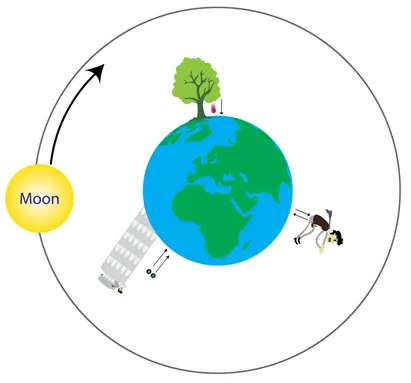
This
image illustrates that gravity works both in space and on Earth's surface.
Introduction
Welcome to the series of Physical Science units
of this course!
In the previous series of units, you explored Earth Science concepts, including the formation of Earth, its layers, and their movement. In this series of units, you will deepen your understanding of forces and movement, broadening it from our understanding of Earth's formation and movement to consider how these forces help us to predict and describe the movement of objects.
Making a Prediction: Observe the photo below. In your science journal,
answer the following questions.

This image showing children playing a ball game
together was taken from https://www.dreamstime.com/.
1. What
do you think happened to the ball's motion after taking the photo?
2. Why
do you think this happened?
What is
Gravity?
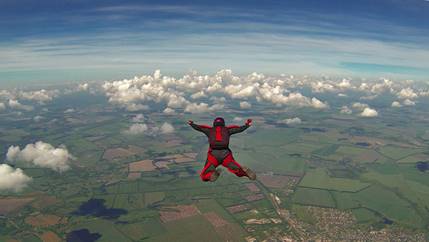
This image, shared on a blog at https://www.skydivecsc.com,
illustrates a skydiver falling toward Earth due to gravity.
Gravity, or gravitational force, is the
attraction of all matter to all other matter. It is the
most familiar of the natural forces and the least understood. The force causes
objects to drop and water to run downhill. It is also the force that holds
Earth, the Sun, and the stars together and keeps planets, moons, and artificial
satellites in their respective orbits.
Gravity is an invisible force that pulls everything down to the ground (Earth's surface).
Everything on Earth is affected by gravity: people, plants, animals, and
objects. Without gravity, you wouldn't be able to go down a slide, play
basketball, or skydive.
Understanding
Concepts:
Click on the link below and watch the video about gravity.
In your science
journal,
answer the following questions:
1. How is the force of
gravity commonly seen on Earth?
2. How do we know that
gravity is a force?
3. Why do we think that
the force of gravity is not strong?
4. What causes the large
rock in the video to break into pieces?
Gravity
on Earth
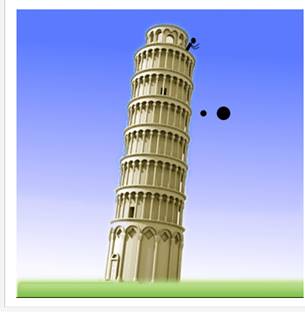
This
image illustrates Galileo's scientific experiment on the role of gravity on
falling objects. It is taken from https://www.wolframcloud.com/.
The video that you just watched illustrated gravity on Earth's
surface. On Earth, gravity pulls
objects toward the center of Earth. This is what makes objects fall. We notice
gravity when a leaf falls to the ground, a tossed ball lands on the ground, and
rain lands on our umbrella.
The Italian astronomer Galileo performed the first
scientific studies of gravity at the end of the 16th century. He conducted
several studies and developed mathematical models about the effect of gravity
on falling objects. Galileo found that gravity causes all objects to accelerate
toward Earth at the same rate, regardless of mass. No matter how large or small
an object is, it will fall at the same rate. Later, Newton calculated this acceleration
as 9.8 meters per second squared. Thus, at the end of one second, a falling
object is moving at a rate of 9.8 meters per second; at the end of two seconds,
it is moving at 19.6 meters per second, and so on.
Galileo's conclusions disproved the earlier
speculations of the ancient Greek philosopher Aristotle, who proposed that
heavy objects fall faster than light objects. However, Galileo's principle
holds only when the falling objects are in a vacuum—that is, a closed system
where there is no air. In an open system with air, the force of air resistance
will push against falling objects and slow their descent.
Considering
the Scientific Process: Watch the video about freefall.
In your science
journal,
answer the following questions:
1. How did Galileo conduct
his experiment? What did he control, and what did he conclude?
2. Why is Galileo's
conclusion different than Aristotle's (and our own) daily observations of
falling objects?
Gravity
in Space
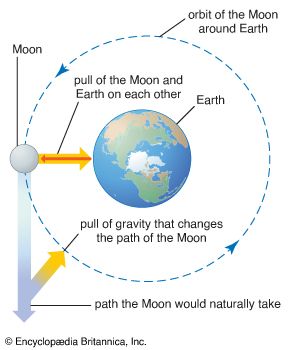
This
image showing the pull of gravity's role in keeping the moon in its orbit
around Earth is taken from Encyclopedia Britannica, Inc.
In the solar system, the planets all orbit, or
travel around, the Sun in a constant path. They would move in a straight line,
but gravity pulls them toward the Sun. At the same time, the speed of the
planets in their orbits keeps them from falling into the Sun.
Spacecraft and satellites similarly travel around
Earth. Earth's gravity keeps them in orbit, and their speed keeps them from
falling back to Earth.
When astronauts are inside a spacecraft in orbit,
they experience weightlessness. The astronauts float freely because they travel
around Earth at the same speed as the spacecraft. But even though Earth's
gravity does not pull them toward the floor—as it does on Earth—they have not
escaped it. Earth's gravity keeps the astronauts in orbit, just as it does the
spacecraft.
Understanding
Concepts:
Watch the video about gravity.
In your science
journal,
answer the following question:
1. What would happen to
our planet without gravity?
2. What is the role of the
Sun in our solar system?
Law of
Gravitation
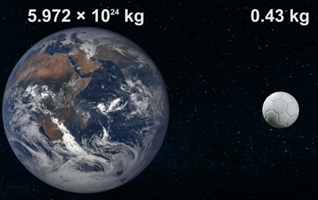
This
image shows the extreme mass difference between the Earth and a soccer ball
from the Encyclopedia Britannica, Inc. video.
Isaac Newton, an English scientist, built on Galileo's
experiment, calculating the rate at which gravity accelerates objects, and discovered
a law, or truth, about gravity in the late 1600s. Newton said that all objects
exert gravitation force on each other and that the amount of this force depends
on their mass or the amount of material they contain. The greater the mass of
an object, the greater its force of gravity. For example, the Sun, which has a
very large mass, has a greater force of gravity than Earth, which has a much
smaller mass. Even a speck of dust has a force of gravity. But its gravity is
very, very small.
The force of gravity also depends on the distance
between two objects. The smaller the distance, the greater the force of gravity
between them.
Every object with mass exerts a gravitational force on every
other object with mass. These forces are hard to detect unless at least one of
the objects is very massive (e.g., sun, planets). The gravitational force
increases with the mass of the objects, decreases rapidly with increasing
distance, and points toward the center of objects.
Understanding
Concepts:
Watch the video about Newton's law of gravitation.
In your science
journal,
answer the following questions:
1. What are the two
factors that affect the gravitational force?
2. What is one example of
the result of the gravitational force between the Earth and the moon?
Let's Practice
Revisiting your Prediction:
Observe the photo below. Revisit your science journal
answers to the previously asked questions. Using what you learned in this unit,
which answers would you like to change? Why? Include your response as a new science
journal entry.

This image showing children playing a ball game
together was taken from https://www.dreamstime.com/.
Previously
asked questions
1. What
do you think happened to the ball's motion after taking the photo?
2. Why
do you think this happened?
New science journal
entry:
Which answers would you like to change? Why?